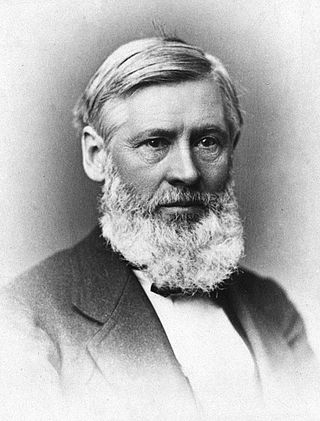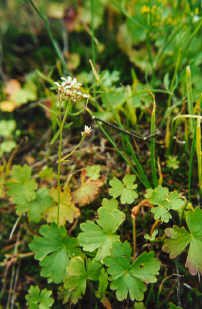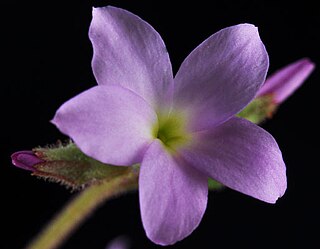
Asa Gray is considered the most important American botanist of the 19th century. His Darwiniana was considered an important explanation of how religion and science were not necessarily mutually exclusive. Gray was adamant that a genetic connection must exist between all members of a species. He was also strongly opposed to the ideas of hybridization within one generation and special creation in the sense of its not allowing for evolution. He was a strong supporter of Darwin, although Gray's theistic evolution was guided by a Creator.

A botanical name is a formal scientific name conforming to the International Code of Nomenclature for algae, fungi, and plants (ICN) and, if it concerns a plant cultigen, the additional cultivar or Group epithets must conform to the International Code of Nomenclature for Cultivated Plants (ICNCP). The code of nomenclature covers "all organisms traditionally treated as algae, fungi, or plants, whether fossil or non-fossil, including blue-green algae (Cyanobacteria), chytrids, oomycetes, slime moulds and photosynthetic protists with their taxonomically related non-photosynthetic groups ."

Parkinsonia, also Cercidium, is a genus of flowering plants in the pea family, Fabaceae. It contains about 12 species that are native to semi-desert regions of Africa and the Americas. The name of the genus honors English apothecary and botanist John Parkinson (1567–1650).
In botany, an infraspecific name is the scientific name for any taxon below the rank of species, i.e. an infraspecific taxon or infraspecies. A "taxon", plural "taxa", is a group of organisms to be given a particular name. The scientific names of botanical taxa are regulated by the International Code of Nomenclature for algae, fungi, and plants (ICN). This specifies a three part name for infraspecific taxa, plus a connecting term to indicate the rank of the name. An example of such a name is Astrophytum myriostigma subvar. glabrum, the name of a subvariety of the species Astrophytum myriostigma.

Priority is a fundamental principle of modern botanical nomenclature and zoological nomenclature. Essentially, it is the principle of recognising the first valid application of a name to a plant or animal. There are two aspects to this:
- The first formal scientific name published for a plant or animal taxon shall be the name that is to be used, called the valid name in zoology and correct name in botany.
- Once a name has been used, no subsequent publication of that name for another taxon shall be valid (zoology) or validly published (botany).
Harold St. John was a professor of botany at the University of Hawaiʻi at Mānoa from 1929 to 1958. A prolific specialist in field botany and systematics, he is credited with naming about 500 new species of Pandanus, along with many other species, especially in the Pacific Islands.

Brodiaea coronaria is the type species of Brodiaea and also known by the common names harvest brodiaea and crown brodiaea. It is native to western North America from British Columbia to northern California, where it grows in mountains and grasslands.

Artemisia suksdorfii is a North American species of sagebrush in the sunflower family. It is known by the common names coastal mugwort, coastal wormwood, and Suksdorf sagewort. It is native to coastal regions from British Columbia, Washington, Oregon, and northern California as far south as Sonoma County, with isolated populations on Santa Catalina Island in Los Angeles County.

Cortinarius violaceus, commonly known as the violet webcap or violet cort, is a fungus in the webcap genus Cortinarius native across the Northern Hemisphere. The fruit bodies are dark purple mushrooms with caps up to 15 cm (6 in) across, sporting gills underneath. The stalk measures 6 to 12 centimetres by 1 to 2 cm, sometimes with a thicker base. The dark flesh has a smell reminiscent of cedar wood. Forming symbiotic (ectomycorrhizal) relationships with the roots of various plant species, C. violaceus is found predominantly in conifer forests in North America and deciduous forests in Europe.

Hemieva ranunculifolia is a species of flowering plant in the saxifrage family known by the common name buttercup suksdorfia. It is the sole species in genus Hemieva. It is native to western North America from British Columbia and Alberta south to northern California. It grows in moist, rocky habitat in mountains and foothills. It is a non-rhizomatous perennial herb growing up to 40 centimeters tall. The leaves have rounded blades up to 4 centimeters wide with several large lobes edged with rounded teeth. The blades are light green, slightly fleshy, hairless in texture, and are borne on petioles up to 15 centimeters long. The inflorescence is a dense, flat-topped cluster of up to 35 flowers borne atop a mostly naked, hairy, glandular stalk. Each flower has a bell-shaped calyx of pointed sepals and five white or pink-tipped petals. The fruit is an oval brown capsule measuring 4 millimeters in length.

Thomas Jefferson Howell was an American botanist. Howell is considered one of the top three self-taught botanists of his era for the Pacific Northwest; the other two being Wilhelm Nikolaus Suksdorf and William Conklin Cusick.

Micranthes is a genus of flowering plants in the saxifrage family. It was formerly included within the genus Saxifraga until recent DNA evidence showed the members of what is now Micranthes are more closely related to Boykinia and Heuchera than to other members of the genus Saxifraga.
Lupinus bingenensis, common name bingen lupine or Suksdorf's lupine, is a plant species native to the US states of Washington, Idaho, Montana and Oregon as well as from British Columbia. Lupinus grows well in mountainous regions. The name honors the city of Bingen, in Klickitat County, Washington.

Wilhelm Nikolaus Suksdorf was an American botanist who specialized in the flora of the Pacific Northwest. He was largely self-taught and is considered one of the top three self-taught botanists of his era for the Pacific Northwest, alongside Thomas Jefferson Howell and William Conklin Cusick.

Suksdorfia violacea is an uncommon species of herbaceous flowering plant in the saxifrage family known by the common name violet suksdorfia. In 1879 Asa Gray named the genus Suksdorfia after Wilhelm Nikolaus Suksdorf who had first collected a specimen of S. violacea in 1878 near Mount Adams-White Salmon, Washington and sent it to Gray for assistance in classifying it. Gray and Suksdorf had a long and close working relationship, and Gray initially identified and named various species found by Suksdorf. Its conservation status has been rated by NatureServe as "G4 – Apparently Secure".
William Conklin Cusick was an American botanist who specialized in the flora of the Pacific Northwest. His botanical knowledge was largely self-taught and he is considered one of the top three self-taught botanists of his era for the Pacific Northwest; the other two being Thomas Jefferson Howell and Wilhelm Nikolaus Suksdorf.

Erythranthe suksdorfii, with the common names Suksdorf's monkeyflower and miniature monkeyflower, is an annual flowering plant in the family Phrymaceae (Lopseed). It was formerly known as Mimulus suksdorfii. A specimen collected in Washington state in 1885 by the self-taught immigrant botanist Wilhelm Nikolaus Suksdorf was identified as a new species by Asa Gray in 1886, who named it in Suksdorf's honor. It can easily be misidentified with Erythranthe breviflora, which generally has elliptic leaves rather than the linear or oblong leaves found in E. suksdorfii.

Lespedeza violacea, commonly known as wand lespedeza or violet lespedeza, is a species of herbaceous plant in the legume family.

Boykinia richardsonii is a species of flowering plant in the family Saxifragaceae, endemic to Alaska and the adjacent Canadian territory of Yukon. It is commonly known as Richardson's brookfoam, but has also been called Alaska boykin, bearflower, Richardson's boykin and Richardson's saxifrage. "Bearflower" reflects its popularity with grizzly bears as forage in the summer months when it flowers.















